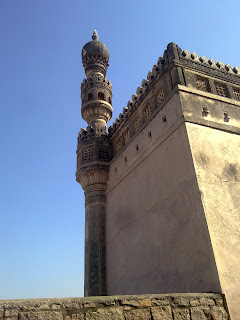I am happy to introduce you to the architecture marvel in Hyderabad - the Golkonda fort.If you are the kind of person who is attracted to historical monuments, to ancient technology and luxury, which surpasses todays inventions, then, Golkonda fort is a must-visit for you.I feel it would take at least 4 complete hours to do complete justice to see everything that is there to offer. And I suggest you wear comfortable footwear(avoid high heels, ladies), since it is a long walk uphill and down.
If you are visiting in summer, God help you. Be ready for huffing and puffing till all the way up and down.We visited in the end of December and it was a little stuffy walking all the way up.Our guide informed us that summers would be scorching there.We were thankful that we visited during winter, when our dear sun was in a cooler mood.
Golkonda gets its name from Golla Konda, Golla referring to the shepherd community and Konda meaning hill in Telugu. Another theory is that it got its name as Gol - meaning round in Hindi/Urdu and Konda meaning hill in Telugu.Personally, I go with the first theory, as the second one seems to combine two languages, which seems to be uncommon. You get the entrance tickets a little away from the foot of the hill. The ticket price is very nominal for us, Indians. The foreign nationals are charged an atrociously higher price - I donot understand this parity of Indian Government, just because they are foreigners, it is unfair to charge a higher amount. Well, thats a topic for another discussion, at another time. Coming back to Golconda, from the ticket area, you walk to the entrance of the fort.The entrance of the fort if concealed behind a wall curtain.The guide mentioned the name of the space between the wall and the main entrance, something to mean a curtain.
 |
| The wall curtain facing the main entrance |
Recollect, how in historical movies- the main gate/entrance is brought down using elephants, big logs. Big logs are used to hit the gate and break it. Elephants were made to run towards the entrance gate and made to hit it with force, to finally break it. Well, that would not have been possible in Golkonda fort. As mentioned earlier, the main entrance gate has a wall curtain to it, so that the main entrance is not visible from outside. Also, it would not be possible to exert pressure using logs and elephants on the main gate, as there is not sufficient place between the wall curtain and the main gate. To reach the main gate you have to walk through the side of the wall curtain. And if elephants are made to come from the side of the wall curtain, they would not be able to exert as much presurre on the gate as they could, if come running from a distance. In addition to that, the guards would be ready to pour cauldrons of hot oil from the compartment above the main entrance on them.
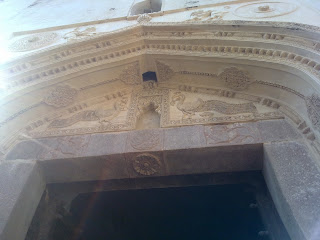 |
| The main entrance(note the hole; from which hot oil could be poured on anyone making a force entry) |
The portico, which you reach from the main entrance is called the Balahisar. One more marvel of this portico is the acoustics - if you clap from a particular point here, it can be heard from a place on the hill top - very clearly. This was humorously called by our guide, the ancient telephone system. This system was used to communicate and alert the guards above on the hill of any danger, or the arrival of any VIP. I believe, they would have coded claps to convey different messages. Now, this is just one more amusement to the visitors.
 |
| A clap from the marked portico is heard in this point. |
Remember the fort is on a hill top, making it difficult to get water on the hill. But the architects of this fort had a solution for this too. While walking up the hill via the common man way(the aam raastha as our guide called it), you are bound to notice clay pipes running along the way. These are connected to the various water tanks( I think there are some four to five water tanks through out the way to the top). The tanks get the water drawn via persian wheels and is distributed to various mahals in the fort via these clay pipes. Our Guide informed us that there are different pipes to carry cold water, hot water, rose water and other scented water(for queens bath).
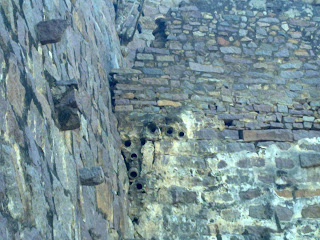 |
| Clay pipes to carry hot, cold, rose and other scented water fitted in the wall |
 |
| Clay pipe to carry water in the wall |
 |
| Clay pipe to carry water in the wall |
 |
| One of the tank to store water |
Golconda was also famous for its precious stones and its immense wealth. It seems each of its walls had innumerable assorted precious stones like rubies, saphires, emeralds embedded in them that there used to be rainbow colors reflections from these stones dazzling the walls. Within the fort, near the main entrance,there was a market, where precious stones were sold. It is called the nagina bazaar. The traders used to be mainly persian, afghans and turks.
 |
| The nagina bazaar |
Diamonds were the speciality of Golkonda during the Kakatiya reign. The famous Darya-e-noor(sea of light) diamond is said to have been found here. During that period, the diamond mines in India were the only known diamond mines in the whole world. Golkonda used to get its diamonds from the nearby Kollur mines and the Paritala mines. The world famous Kohi-noor diamond is also believed to be extracted from the mines of Golkonda.
The royalty who inhabited the Golkanda fort, had built a mortury bath house to the right of the main entrance of the fort, where the dead body of the royal harem is bathed as per the rituals before sending for burial. Water is fed from clay pipes into the cisterns, where the bathing is done.
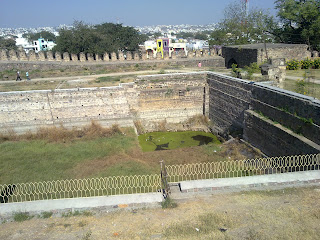 |
| The mortury bath is the elevated room like structure on the right |
One more interesting thing I noticed here is a iron weight lying near the portico. I took I video of it instead of a still photo by mistake. It seems that to be employable in the fort, as a guard, one had to lift this 250 kg weight. It was a test of strength.
When you start walking up, you will come across corridors, which when enclosed with curtains, acted as offices of the ministers. The walls had holes to hold the light. Cotton cloth is wound tightly to the end of a stick and soaked in oil, which is lit. This acted as light during night. These sticks are placed in the holes made to hold the sticks to light up the room. It seems, the holes in the walls also were used to tie curtains to divide the room for privacy, secret meetings. These so called offices had huge places to keep books/records.
 |
| Notice the hole to hold light and to tie curtains |
 |
| Corridors/offices which would be separated by curtains |
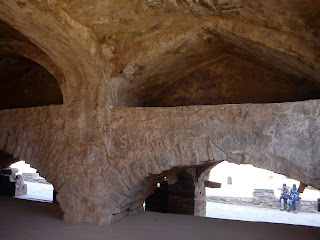 |
Compartments to keep records
|
One more attraction within the fort is the Ramdas jail.According to the legend, Kancharla Gopanna was the appointed as tahsildar(revenue collector) for Bhadrachalam by his uncle Akkanna, who was a minister to the Qutb shahi king Hassan. Gopanna, who was an ardent devotee of Lord Rama, noticing the pitiful state of the temple in Bhadrachalam, used six lakh rupees collected as revenue to rebuild the temple, without taking the permission of the Sultan. When the Sultan came to know about this, he imprisoned Gopanna for misappropiation of public funds, for a period of twelve long years. During his imprisonment, Gopanna, who is popularly called Bhaktha Ramdas, composed and sung many poems in praise of Lord Ram. He carved the sculpture of Lord Ram, Sita, Lakshmana and Hanuman in his jail and worshiped them by singing emotional songs, praying to be released from imprisonment. At the end of may be the twelfth year of imprisonment, legend has it that, the Sultan was visited by two young princes in the middle of the night, who gave him six lakh rupees, and demanded the release of Gopanna. They got Gopanna released on the same night by showing the receipt to the jailor. It is believed that, the young princes were none other than Lord Rama and his brother Lakshman. Sultan, on realising that Lord Rama had visited him, returned the entire money received from Lord Rama to Bhadrachalam. It had become a practice that the Hyderabad state, used to send gifts during Ramnavami every year to Bhadrachalam temple.

 |
| The opening in the ceiling was used to provide food to Ramdas |
 |
| Ramdas carving of Lord Rama,Sita, Lakshman and Hanuman |
 |
| Ramdas carving of Lord Rama,Sita, Lakshman and Hanuman |
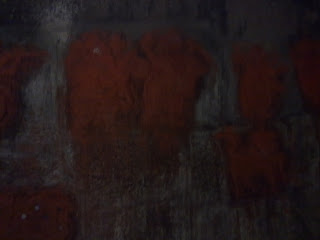 |
| Ramdas carving of Lord Rama,Sita, Lakshman and Hanuman |
When you move up from the corridors/galleries, you reach a open pavilion which houses - the ambhar khana, or the store house of grains. Unfortunately this is closed for visitors now. There is a rock edict in green granite at the entrance written in urdu (which I was unable to read). The fort seems to be self sufficient in all the means. It has system to get water stored and supplied to various mahals, kitchens etc, it has the granary in house..amazing isn't it.
 |
| Rock edict near the Ambhar Khana |
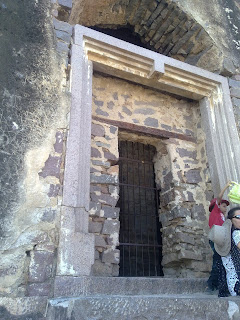 |
| The Ambhar Khana |
There is a high wall adjoining one of the water tanks. The wall is thick at the bottom and thin at the top. Our guide explained that, if some one tries to climb up the wall to poison the water in the tank, the wall would break as it is thin at the top.
 |
Thick base, thin at the top
|
There is a small replica of the charminar, but with only two minars. It seems that this was the model, the blue print(test) made before the charminar was built. We can see the charminar and the Qutub shahi tombs from this point.
On the top of the hill, there is a hindu temple, probably built by the kakatiyas. Atop the place of worship are two giant rocks which our guide informed resembled the legendary Nandi - the bull. He said they are natural formations. But I could clearly see the clean cut in one of the rocks.
The top of the hill has the baradari, which is a two storied building with an open terrace and open audience hall. It has small meeting rooms inside the building as well. It is believed that this is where the sultan used to address the general public in the open audience hall, and for matters involving the digantories of the state, he used the inner meeting rooms. The open terrace was used to have a view of the surrounding.
 |
| View from the top |
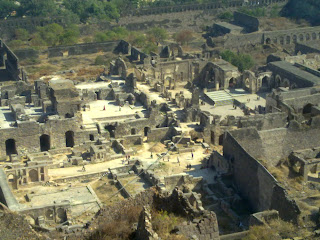 |
| View from the top |
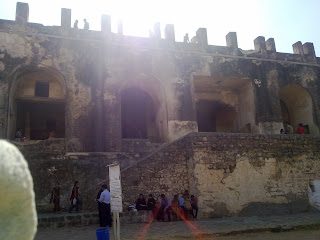 |
| The baradari overlooking the audience hall |
It is also believed that there is a secret passage from the audience hall to the Goshamahal( where the queens live) 8 kilometres away, which the sultan used to visit the queens inconspicuously. The department of archaeological survey of India, had it closed due to security reasons.
From the baradari, it is walk down. We walked up to the baradari via the aam rastha- the way the common man was supposed to go to visit the sultan. But while walking down, we go by the royal way, via a staircase.It is faster and is a shorter distance. It seems that the sultan and his queens were carried in palanquins in this staircase. The palanquin's bearers were chosen such that two were short and two were tall. While climbing up, the shorter ones,held the front of palanquin while the taller ones held the rear side - managing the position of palanquin. Amazing.
 |
| The royal way |
When we climb down, we reach the queens' body guards quarters. The queens body guards were eunuchs, who were physically strong to protect the royal harem, and at the same time did not have any danger to the harem from them selves.Once we cross the body guards quarters, we come to the queens palace, queens make up room, etc. Unfortunately,I have not taken the photographs of these. After the queens rooms, we come to audience hall of some kind, where the sound and music show is organised.
After crossing the hall, we pass through some corridors and galleries. In one of the galleries, something spoken in one corner of the room, was clearly heard at another corner of the room, as if spoken next to you. And in one of the corridors, I forgot the name - it was the place where a culprit is brought to have an audience with the Sultan. The sultan/or the royal ladies, sat at a tower above the corridor, and would not be visible to the culprit. The place where the culprit stood, is remarkable, as even rustling of cloth is heard as a echo. So any tricks played by the culprit to bring out any hidden weapon is usually caught in time. So Golkonda's acoustics are a marvel unto themselves.
Towards the end of the visit, there is the armory, were all the ammunition was stored. Also found is a room like compartment, which is connected to the top of the main entrance, where oil is heated in cauldrons to be poured on the enemy.



In the evening, we attended the sound and music show. It was lovely - the history of Golkonda was explained with music,dialogues and light.
Below are few more photographs of the architectural wonder.





Now lets see the history of Golkonda: It seems that a shepherd boy accidentally found an idol on a hill, which was then called mangalavaram.When this was communicated to the then ruling Kakatiya King, he built a mud fort around the idol. So the original architects of the fort were the Kakatiya's of Warangal.This is testified by the over - door carvings and work in stucco consisting of lions, peacocks, yali, and lotus at the entrance of Balahisar.In AD1363 it came under the Bahmani dynasty.After their downfall, it came under the rule of Qutub shahi dynasty, who made it their capital(AD 1518-1687).The fort was extended and substantially strengthened by these kings with massive fortification walls having bastions and battlements. The pride of beautification of the fort goes to Sultan Quli Qutub Shah, who made it drawing inspiration from the Turk cities. Later, it came under the rule of Aurangazeb, who annexed it to the Mughal Empire (AD 1687) during the reign of Abul Hassan Tana Shan, the last ruler of the Qutb Shahi dynasty and appointed Asaf Jah as the Zubedar of the Deccan province. Asaf Jah declared independence in AD1713 as Nizam-ul-Mulk and the Nizams held sway over Hyderabad until AD 1948.
Now lets see the structure :Golkonda fort, is one of the most famous and the biggest forts in the Deccan plateau, was built on a 400 ft. high hill. It has three lines of massive fortification walls one within the other and rise to a height of over 12 m. The outer most wall was provided with a deep moat all around covering a vast area of the town with a circumference of 7 km. It has 8 imposing gateways and is buttressed with 87 bastions rising to a height of 15 to 18 meters. Each of these bastions was surmounted by cannons of varying caliber rendering the fort impregnable and strong among the forts of the medieval Deccan.
After the outer wall it has also a double wall that runs around the foot of the hill on which the citadel stands. Within the double wall, winding further up the hill, connecting the natural boulders with masonry walls is a third wall. An extension of the outer wall was made to enclose a small area on the northeast of the town in 1724 AD, which is now known as Naya Qila.
Well, all those who visit Hyderabad - donot restrict yourselves to the Charminar, Hussain sagar and necklace road. Do make time and visit Golconda fort.
P.S. It is very eerie to look at it at night, after the lights are off. Gives you creeps.
































